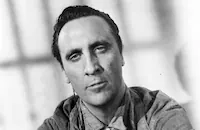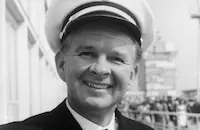What's the Matter with Helen?

Brief Synopsis
Cast & Crew
Curtis Harrington
Debbie Reynolds
Shelley Winters
Dennis Weaver
Michael Macliammóir
Agnes Moorehead
Film Details
Technical Specs

Synopsis
In the small town of Braddock, Iowa, in the 1930s, Adelle Bruckner and Helen Hill become pariahs when their sons are sentenced to life in prison for the brutal murder of Ellie Banner. After a man phones Helen and threatens that "she will pay for what her boys did," the divorced Adelle, who fashions herself as a "Jean Harlow" type, decides to move her dancing school to California where she plans to turn out "little Shirley Temples." When Adelle invites the frumpy Helen to join her, the women decide to start new lives in Hollywood. At Adelle's Academy of Dance, Helen accompanies the little dancers on the piano while their stage mothers eagerly await the appearance of talent scouts. One day, Adelle decides to glamorize Helen, and as she cuts her hair, Helen winces at the sight of the scissors, then recalls the death of her husband Matt: While plowing the fields of their farm, Matt loses control of the horses and is mangled by the plow blades. Her four-year-old son witnesses the accident and blames her because she was not able to stop the horses. Soon after, the haircut, overly histrionic actor Hamilton Starr comes to the academy to offer his services as an elocution teacher for Adelle's little charges. Even though Helen takes an immediate dislike to Starr, Adelle accepts his offer. The next day, Texan Lincoln Palmer, the divorced, wealthy father of Adelle's student Winona, comes to watch his daughter rehearse and is smitten by Adelle. Linc invites Adelle to dinner, and when he asks her if she has ever been married, she lies that she has never met "the right man." That night, when Linc brings the tipsy Adelle home and kisses her, the prudish Helen looks on disapprovingly. The next day, as Helen begins to decorate the dance studio for an upcoming recital, Adelle informs her that Linc has rented a real theater for the event. Feeling rejected, Helen asks if Adelle told Linc about her son, making Adelle angry because she fears that Linc would not be interested in her if he knew the truth. Helen gradually begins to suffer a nervous breakdown, and during the recital, she deliberately sticks her hand into a moving fan and screams, ruining the performance. Helen's mental condition worsens when she goes into the cellar and finds that the cardboard cutout of Adelle used to advertise the studio has been mutilated. That night, when Linc picks up Adelle for a date, he shows her a newspaper clipping he received in the mail about the Banner murder. When Adelle accuses Helen of sending it, Linc reassures her that he does not care if her son was accused of murder and offers to pay for an appeal. Meanwhile, Helen sinks deeper into her paranoia and turns to a radio sermon given by revivalist Sister Alma for solace. Upon returning home, Adelle accuses Helen of trying to derail her romance with Linc and orders her to move out. After Adelle leaves with Linc the following evening, Helen is packing her suitcase when a man enters the house and ascends the stairs, asking if she got his letter. Panicked, Helen pushes the man down the stairs to his death. Returning to the studio, Adelle is shocked to find a dead body in the hallway. When she finds a letter he was carrying, notifying Helen that she has inherited money from a relative, Adelle, fearful of Linc finding out, insists on immediately disposing of the body without notifying the police. In the pouring rain, the women lug the body to a construction site across the street and dump it into an open trench. The body is found by the police the next day, and while Adelle sleeps that night, Helen listens to Sister Alma on the radio, who exhorts all sinners to confess their mistakes to God. When Adelle awakens and finds Helen gone and hears Sister Alma on the radio, she realizes that Helen went to the sister's church and hurries to stop her. Adelle arrives as Helen approaches Sister Alma and begs to confess. Not interested in Helen's confession, Sister Alma dismisses her, causing Helen to become hysterical. Adelle grabs the raving woman and hustles her home, where Helen blames Adelle for her anguish because she stopped Sister Alma from granting her absolution from her sins. That night, after Linc takes Adelle out, he proposes to her. When she accepts, he suggests they immediately drive to Arizona to be married and takes her home to pack some clothes. Adelle arrives home to find the walls splattered with blood and discovers that Helen has slaughtered the pet rabbits she had lovingly raised. Helen, who is now insane, confronts Adelle and admits that she pushed her husband in front of the plow. Adelle tries to humor Helen, but when she mentions that she and Linc are getting married, Helen stabs her to death. Soon after, Det. Sgt. West from Braddock arrives and shows her a photo of the man they found in the trench. When Helen denies knowing the man, West tells her that he was Ellie Banner's lover and was seeking revenge on the mothers of her killers. After West leaves, Helen runs to tell the news to Adelle. Later, when Linc comes to pick up Adelle, he finds Helen pounding out a song on the piano and Adelle's corpse, dressed in her dancing costume, propped up on the stage by a ladder.

Director
Curtis Harrington
Cast

Debbie Reynolds

Shelley Winters

Dennis Weaver
Michael Macliammóir

Agnes Moorehead
Helene Winston
Peggy Rea
Logan Ramsey
Paulle Clark

Yvette Vickers
Molly Dodd
Sammee Lee Jones
Robbi Morgan

Timothy Carey
Swen Swenson
Debbie Van Den Houten
Teresa De Rose
Pamelyn Ferdin
Allen Pinson

James Dobson
Sadie Delfino
Tammy Lee
Sharon Hisamoto
Stacey Hollow
Marcia Garcia
Bambi Meyers
Roxanne Meyers
Vicki Schreck
Keri Shuttleton
Shawn Steinmann
Madelon Tupper
Sian Winship
Harry Stanton
Peggy Lloyd Patten
Gary Combs
Sadie Delfino
Annette Davis
Helene Heigh

Peter Brocco
Minta Durfee Arbuckle
Peggy Walton
Douglas Deane
Crew
Michael Anderson
Ted P. Angel
Lucien Ballard
Bill Beaumont
Hal Belcher
Claude Binyon Jr.
Irving Caesar
Tony Charmoli
Paulle Clark
Glen Cooper
Darlene Di Ponzio
Robert Edouart
Fanny Edwards
George Edwards
Henry Farrell
Edward S. Feldman
John Franco Jr.
Bud Gaunt
Earl Gilbert
Gary Glieberman
Les D. Gobruegge
Allan Greedy
Bud Grenzbach
Sydney Guilaroff
Morton Haack
Ray Henderson
R. Dudley Holmes
Bud Howell
Betty Iverson
Ralph Ives
Caro Jones
Dorothy Kelly
Ted Koehler
John Lenox
Sally Lister
Tom Loughridge
Eugene Lourie
Cecil Lupton
Jerry Macdonald
Andy Matyasi
Matt Melneck
John Mercer
Mike Messinger
Terri Nelson
Al Overton Jr.
Helene Parrish
James C. Pratt
Scott Rackin
David Raksin
Martin Ransohoff
Randy Rayburn
William Reynolds
William H. Reynolds
Jerry Roberts
Bob Schunke
Lorraine Serber
Carl Shapiro
Bob Sheridan
Sterling Smith
John Philip Sousa
Tad Tadlock
Frank Tauss
William Tuttle
Jim Wells
Buddy Woodside
Jerry Wunderlich
Jack Yellen
Harry Young

Videos
Movie Clip
Trailer
Film Details
Technical Specs

Award Nominations
Best Costume Design
Articles
What's the Matter With Helen?
By Frank Miller

What's the Matter With Helen?
Quotes
Trivia
Notes
The working titles of the film were The Box Step and The Best of Friends. The full onscreen copyright statement listing the film's claimants reads; Filmways, Inc., Raymax Productions, Inc., Raven Productions, Inc. & Virgo International Pictures, Inc. Before the opening credits roll, a series of Hearst Metrotone Newsreels depicting Franklin and Eleanor Roosevelt and the fictional Hill-Bruckner trial are shown.
Many reviews commented on the similarity between What's the Matter with Helen? and the 1962 Robert Aldrich film What Ever Happened to Baby Jane?. Henry Farrell, who wrote the script for What's the Matter with Helen?, wrote the novel on which What Ever Happened to Baby Jane? was based. According to a January 1971 article in Los Angeles Times and a December 1970 Variety news item, director Curtis Harrington and producer George Edwards, who at the time were working for Universal Pictures, were so impressed by What Ever Happened to Baby Jane? that they asked Farrell if he had any other properties available. Farrell was at the time working on a story called "The Box Step," a contemporary story about two ladies who ran a dance school, but it had already been optioned by Farrell's agent. The property was assigned to another director at Universal, and Farrell was commissioned to write the screenplay.
Universal eventually decided to abandon the property and asked Harrington and Edwards if they still wanted it. At that time, Harrington and Edwards changed the period to the 1930s and offered the lead to Joanne Woodward, who turned it down. Months later, after leaving Universal, Harrington and Edwards took the project to Edward S. Feldman at Filmways, who was looking for a script for Debbie Reynolds. According to Filmfacts, Reynolds invested $800,000 in the production. A September 1969 Daily Variety news item added that the producers were negotiating with Estelle Parsons to star in the film. The Los Angeles Times article added that Winters was threatened with the replacement of Geraldine Page if she did not become easier to work with. According to a January 1971 Hollywood Reporter news item, the scenes depicting the Kansas farm were shot on location in the Palos Verdes area of California. The film received an Academy Award nomination for Best Costume Design. A few months after completing What's the Matter with Helen?, Harrington directed another film starring Winters, Who Slew Auntie Roo?, which was shot in England and released in December 1971 (see below).

Miscellaneous Notes
Released in United States Summer June 1971
Released in United States Summer June 1971















